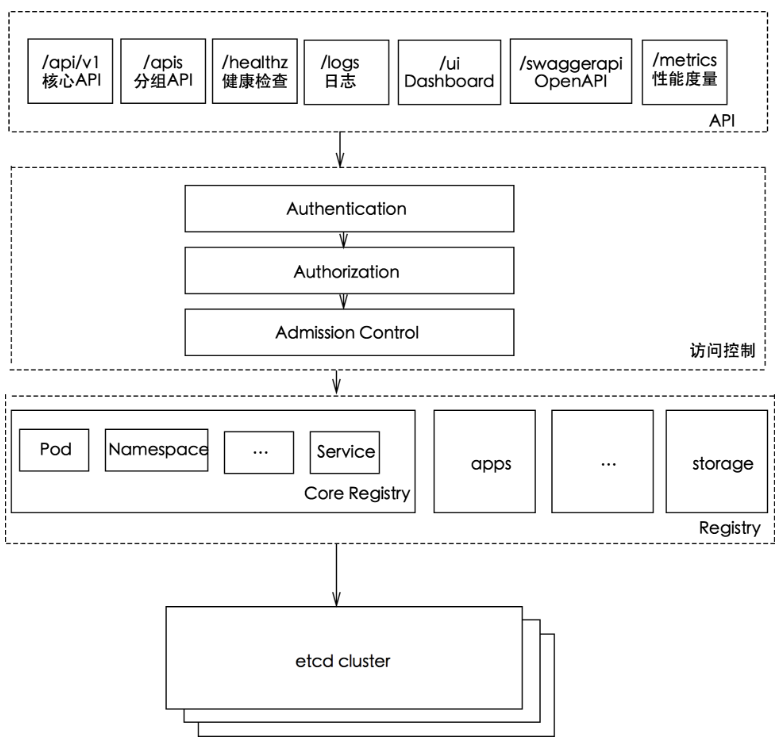Kubernetes核心原理(一)之API Server
1. API Server简介
k8s API Server提供了k8s各类资源对象(pod,RC,Service等)的增删改查及watch等HTTP Rest接口,是整个系统的数据总线和数据中心。
kubernetes API Server的功能:
- 提供了集群管理的REST API接口(包括认证授权、数据校验以及集群状态变更);
- 提供其他模块之间的数据交互和通信的枢纽(其他模块通过API Server查询或修改数据,只有API Server才直接操作etcd);
- 是资源配额控制的入口;
- 拥有完备的集群安全机制.
kube-apiserver工作原理图

2. 如何访问kubernetes API
k8s通过kube-apiserver这个进程提供服务,该进程运行在单个k8s-master节点上。默认有两个端口。
2.1. 本地端口
- 该端口用于接收HTTP请求;
- 该端口默认值为8080,可以通过API Server的启动参数“--insecure-port”的值来修改默认值;
- 默认的IP地址为“localhost”,可以通过启动参数“--insecure-bind-address”的值来修改该IP地址;
- 非认证或授权的HTTP请求通过该端口访问API Server。
2.2. 安全端口
- 该端口默认值为6443,可通过启动参数“--secure-port”的值来修改默认值;
- 默认IP地址为非本地(Non-Localhost)网络端口,通过启动参数“--bind-address”设置该值;
- 该端口用于接收HTTPS请求;
- 用于基于Tocken文件或客户端证书及HTTP Base的认证;
- 用于基于策略的授权;
- 默认不启动HTTPS安全访问控制。
2.3. 访问方式
Kubernetes REST API可参考https://kubernetes.io/docs/api-reference/v1.6/
2.3.1. curl
curl localhost:8080/api
curl localhost:8080/api/v1/pods
curl localhost:8080/api/v1/services
curl localhost:8080/api/v1/replicationcontrollers
2.3.2. Kubectl Proxy
Kubectl Proxy代理程序既能作为API Server的反向代理,也能作为普通客户端访问API Server的代理。通过master节点的8080端口来启动该代理程序。
kubectl proxy --port=8080 &
具体见kubectl proxy --help
[root@node5 ~]# kubectl proxy --help
To proxy all of the kubernetes api and nothing else, use:
kubectl proxy --api-prefix=/
To proxy only part of the kubernetes api and also some static files:
kubectl proxy --www=/my/files --www-prefix=/static/ --api-prefix=/api/
The above lets you 'curl localhost:8001/api/v1/pods'.
To proxy the entire kubernetes api at a different root, use:
kubectl proxy --api-prefix=/custom/
The above lets you 'curl localhost:8001/custom/api/v1/pods'
Usage:
kubectl proxy [--port=PORT] [--www=static-dir] [--www-prefix=prefix] [--api-prefix=prefix] [flags]
Examples:
# Run a proxy to kubernetes apiserver on port 8011, serving static content from ./local/www/
$ kubectl proxy --port=8011 --www=./local/www/
# Run a proxy to kubernetes apiserver on an arbitrary local port.
# The chosen port for the server will be output to stdout.
$ kubectl proxy --port=0
# Run a proxy to kubernetes apiserver, changing the api prefix to k8s-api
# This makes e.g. the pods api available at localhost:8011/k8s-api/v1/pods/
$ kubectl proxy --api-prefix=/k8s-api
Flags:
--accept-hosts="^localhost$,^127//.0//.0//.1$,^//[::1//]$": Regular expression for hosts that the proxy should accept.
--accept-paths="^/.*": Regular expression for paths that the proxy should accept.
--api-prefix="/": Prefix to serve the proxied API under.
--disable-filter[=false]: If true, disable request filtering in the proxy. This is dangerous, and can leave you vulnerable to XSRF attacks, when used with an accessible port.
-p, --port=8001: The port on which to run the proxy. Set to 0 to pick a random port.
--reject-methods="POST,PUT,PATCH": Regular expression for HTTP methods that the proxy should reject.
--reject-paths="^/api/.*/exec,^/api/.*/run": Regular expression for paths that the proxy should reject.
-u, --unix-socket="": Unix socket on which to run the proxy.
-w, --www="": Also serve static files from the given directory under the specified prefix.
-P, --www-prefix="/static/": Prefix to serve static files under, if static file directory is specified.
Global Flags:
--alsologtostderr[=false]: log to standard error as well as files
--api-version="": The API version to use when talking to the server
--certificate-authority="": Path to a cert. file for the certificate authority.
--client-certificate="": Path to a client key file for TLS.
--client-key="": Path to a client key file for TLS.
--cluster="": The name of the kubeconfig cluster to use
--context="": The name of the kubeconfig context to use
--insecure-skip-tls-verify[=false]: If true, the server's certificate will not be checked for validity. This will make your HTTPS connections insecure.
--kubeconfig="": Path to the kubeconfig file to use for CLI requests.
--log-backtrace-at=:0: when logging hits line file:N, emit a stack trace
--log-dir="": If non-empty, write log files in this directory
--log-flush-frequency=5s: Maximum number of seconds between log flushes
--logtostderr[=true]: log to standard error instead of files
--match-server-version[=false]: Require server version to match client version
--namespace="": If present, the namespace scope for this CLI request.
--password="": Password for basic authentication to the API server.
-s, --server="": The address and port of the Kubernetes API server
--stderrthreshold=2: logs at or above this threshold go to stderr
--token="": Bearer token for authentication to the API server.
--user="": The name of the kubeconfig user to use
--username="": Username for basic authentication to the API server.
--v=0: log level for V logs
--vmodule=: comma-separated list of pattern=N settings for file-filtered logging
2.3.3. kubectl客户端
命令行工具kubectl客户端,通过命令行参数转换为对API Server的REST API调用,并将调用结果输出。
命令格式:kubectl [command] [options]
具体可参考k8s常用命令
2.3.4. 编程方式调用
使用场景:
1、运行在Pod里的用户进程调用kubernetes API,通常用来实现分布式集群搭建的目标。
2、开发基于kubernetes的管理平台,比如调用kubernetes API来完成Pod、Service、RC等资源对象的图形化创建和管理界面。可以使用kubernetes提供的Client Library。
具体可参考https://github.com/kubernetes/client-go。
3. 通过API Server访问Node、Pod和Service
k8s API Server最主要的REST接口是资源对象的增删改查,另外还有一类特殊的REST接口—k8s Proxy API接口,这类接口的作用是代理REST请求,即kubernetes API Server把收到的REST请求转发到某个Node上的kubelet守护进程的REST端口上,由该kubelet进程负责响应。
3.1. Node相关接口
关于Node相关的接口的REST路径为:/api/v1/proxy/nodes/{name},其中{name}为节点的名称或IP地址。
/api/v1/proxy/nodes/{name}/pods/ #列出指定节点内所有Pod的信息
/api/v1/proxy/nodes/{name}/stats/ #列出指定节点内物理资源的统计信息
/api/v1/prxoy/nodes/{name}/spec/ #列出指定节点的概要信息
这里获取的Pod信息来自Node而非etcd数据库,两者时间点可能存在偏差。如果在kubelet进程启动时加--enable-debugging-handles=true参数,那么kubernetes Proxy API还会增加以下接口:
/api/v1/proxy/nodes/{name}/run #在节点上运行某个容器
/api/v1/proxy/nodes/{name}/exec #在节点上的某个容器中运行某条命令
/api/v1/proxy/nodes/{name}/attach #在节点上attach某个容器
/api/v1/proxy/nodes/{name}/portForward #实现节点上的Pod端口转发
/api/v1/proxy/nodes/{name}/logs #列出节点的各类日志信息
/api/v1/proxy/nodes/{name}/metrics #列出和该节点相关的Metrics信息
/api/v1/proxy/nodes/{name}/runningpods #列出节点内运行中的Pod信息
/api/v1/proxy/nodes/{name}/debug/pprof #列出节点内当前web服务的状态,包括CPU和内存的使用情况
3.2. Pod相关接口
/api/v1/proxy/namespaces/{namespace}/pods/{name}/{path:*} #访问pod的某个服务接口
/api/v1/proxy/namespaces/{namespace}/pods/{name} #访问Pod
#以下写法不同,功能一样
/api/v1/namespaces/{namespace}/pods/{name}/proxy/{path:*} #访问pod的某个服务接口
/api/v1/namespaces/{namespace}/pods/{name}/proxy #访问Pod
3.3. Service相关接口
/api/v1/proxy/namespaces/{namespace}/services/{name}
Pod的proxy接口的作用:在kubernetes集群之外访问某个pod容器的服务(HTTP服务),可以用Proxy API实现,这种场景多用于管理目的,比如逐一排查Service的Pod副本,检查哪些Pod的服务存在异常问题。
4. 集群功能模块之间的通信
kubernetes API Server作为集群的核心,负责集群各功能模块之间的通信,集群内各个功能模块通过API Server将信息存入etcd,当需要获取和操作这些数据时,通过API Server提供的REST接口(GET/LIST/WATCH方法)来实现,从而实现各模块之间的信息交互。
4.1. kubelet与API Server交互
每个Node节点上的kubelet定期就会调用API Server的REST接口报告自身状态,API Server接收这些信息后,将节点状态信息更新到etcd中。kubelet也通过API Server的Watch接口监听Pod信息,从而对Node机器上的POD进行管理。
| 监听信息 | kubelet动作 |
|---|---|
| 新的POD副本被调度绑定到本节点 | 执行POD对应的容器的创建和启动逻辑 |
| POD对象被删除 | 删除本节点上相应的POD容器 |
| 修改POD信息 | 修改本节点的POD容器 |
4.2. kube-controller-manager与API Server交互
kube-controller-manager中的Node Controller模块通过API Server提供的Watch接口,实时监控Node的信息,并做相应处理。
4.3. kube-scheduler与API Server交互
Scheduler通过API Server的Watch接口监听到新建Pod副本的信息后,它会检索所有符合该Pod要求的Node列表,开始执行Pod调度逻辑。调度成功后将Pod绑定到目标节点上。
4.4. 特别说明
为了缓解各模块对API Server的访问压力,各功能模块都采用缓存机制来缓存数据,各功能模块定时从API Server获取指定的资源对象信息(LIST/WATCH方法),然后将信息保存到本地缓存,功能模块在某些情况下不直接访问API Server,而是通过访问缓存数据来间接访问API Server。
参考《kubernetes权威指南》
Feedback
Was this page helpful?
Glad to hear it! Please tell us how we can improve.
Sorry to hear that. Please tell us how we can improve.